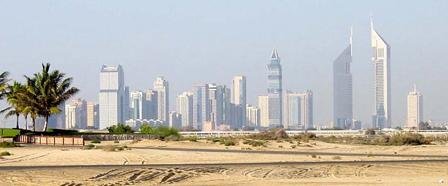 |
Dubai
City,
United Arab Emirates
Articles/Pictures
collected
by
Rick Archer
First Published:
May 2006
Last Update: January 2008
|
|
Is this a mirage in the Middle East?
Seemingly out
of nowhere emerges an
ultra-modern city in the middle of a desert.
Dubai City
is currently
undergoing an unbelievable transformation right in
the heart of the Arab world.
Dubai, population one million,
produces some of
the best modern architecture in the world.
Considered
the world's fastest
growing city, it is estimated that there are 90
billion dollars worth of projects being built in
Dubai City right this minute.
Using the success
of our own Las Vegas as a model that a hostile
environment can be tamed to meet man’s will, there
is one fairy tale structure after another being
built.
Among the
accomplishments are the Burj Al Arab Hotel,
considered the world’s most expensive and beautiful
hotel. Nearby you can see the Burj Dubai Tower.
When it is completed in 2008, it will become the
world’s tallest building. In the middle of the
desert you can see the world’s largest theme park
being built. Known as “Dubailand”, when finished in
2009 it will feature full size Jurassic Park-style
dinosaur recreations among other things. Or you can
visit the world’s biggest ski dome at the Mall of
the Emirates. That’s right, they are building a ski
slope in the middle of the desert.
And you can go to the shores of the Persian Gulf and
view fantastic man-made islands featuring some of
the most expensive houses in the entire world.
Dubai City is
definitely something out of a science fiction novel.
In fact, I wouldn’t be surprised if you thought I
was making this up! Recently my friend Carol
Gafford sent me some amazing pictures. Definitely
do yourself a favor and go look for yourself!
Dubai is already the home to
Burj Al Arab, the world's tallest hotel and
to Emirates Towers, the tallest
all-residential building in the world. In 2008 these two structures will be joined by the 'Burj
Dubai' which when finished will become the
world's tallest building.
While the skyline is not so dense, each
building is a marvel all on its own.
The individual
buildings in this city are by far the greatest
examples of modern architectural accomplishments.
All seven structures in this city at over 200 meters
tall were built in 1999 or later - that's how new
this city is.
|
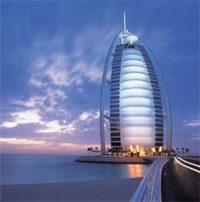 |
|
|
 |
Dubai City is located on the
shores of the Persian Gulf. It is the capital
of Dubai which is one of seven "Emirates" or states
that form a country known as the United Arab
Emirates. The 'Emirate of Dubai' is about the
size of America's Rhode Island.
Dubai City does not have a particularly long
history. Since it is located in an
unbelievably harsh terrain, there have been very few
battles fought here since no one wanted any part of
this land!
Dubai first gained distinction in the 1800s as a
stopover for ships making their way to and from
England to India. Dubai was under the
protection of the British Empire until 1971 when
Britain left the area peacefully.
Shortly after, oil was discovered just off the
coast. Suddenly Dubai was rich beyond anyone's
wildest imagination. It was like winning the
lottery.
|
Dubai is a very unusual city
for many reasons.
The majority of its population is from "somewhere
else". Citizens of the UAE are in a distinct
minority. Naturally the Muslim religion
predominates, but apparently religious tolerance is
very high in this area which is rather unusual given
the state of the world today. As a result, people of all
religions feel welcome here.
One fascinating part of this bizarre
desert city is the unbelievable construction
boom. Since 2000, Dubai's municipality
has initiated a plethora of construction
phases and plans across the entire city of
Dubai.
In many areas, it is not easy to see Dubai's
sky without at least one crane in your view;
some say 16% of the world's large
construction cranes reside in Dubai.
Construction in Dubai and the UAE in general
is being done at a much faster process than
in any Western country. This is partly
because laborers from the Indian
subcontinent accept lower wages than those
from other countries.
Ever since Dubai was flooded by the increase of population during the
early days of oil, housing has been difficult to
obtain. That is when the novel idea of
building homes on artificial islands out in the
middle of the water was developed. One of the
first developments was "Jumeira
Palm Island" pictured at right.
Then came "The World", a series of man-made
islands with homes that only the mega-rich
could ever hope to afford. Ownership
of an island home at "The World" is
considered just as desirable as a home in
Aspen, Monaco, and other favorite
hangouts of the Rich and Famous.
The main reason for the construction boom in Dubai is its drive to
diversify the economy. The Dubai government
does not want to depend on its oil reserves
which are largely believed to become
exhausted by 2010. Accordingly Dubai
City has diversified
its economy to attract revenues in the form
of expanding commercial and corporate
activity.
Tourism is being promoted at a
staggering rate with the construction of Dubailand and other projects that include
the making of mammoth shopping malls, theme
parks, resorts, stadiums and other various
tourist attractions.
They even have a ski slope under
construction. The concept seems completely preposterous until one
considers a certain city in the USA known as
"Las Vegas".
When you factor in a considerable amount of
gambling and prostitution - activities that
are practically unthinkable in other Arab
countries, the parallels to Las Vegas are
inescapable.
|
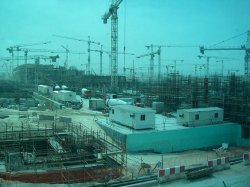
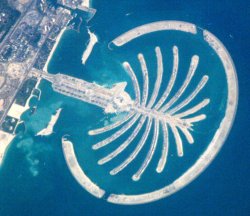
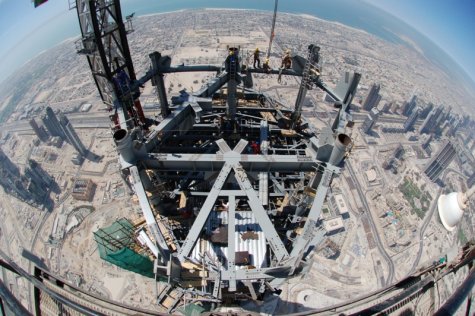 |
|
|
|
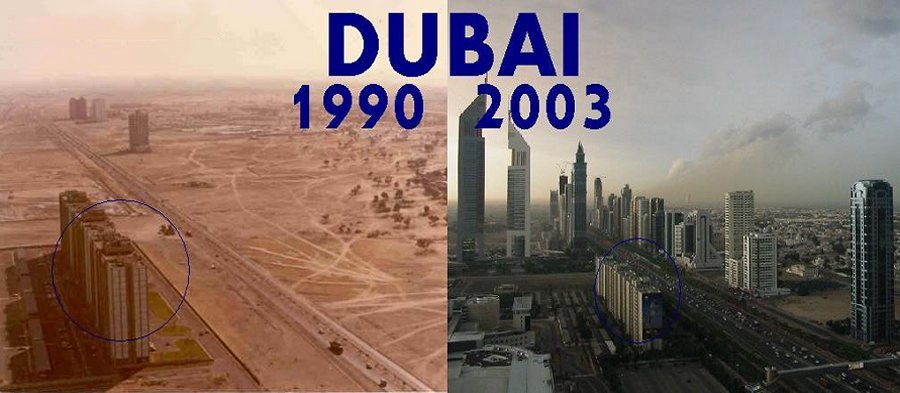 |
| |
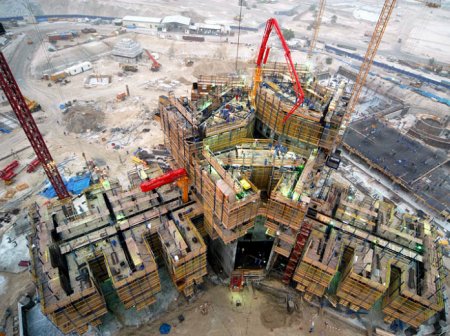
Battle of the Tower Cranes |

15% of the world tower cranes are currently in Dubai. |
| |
|
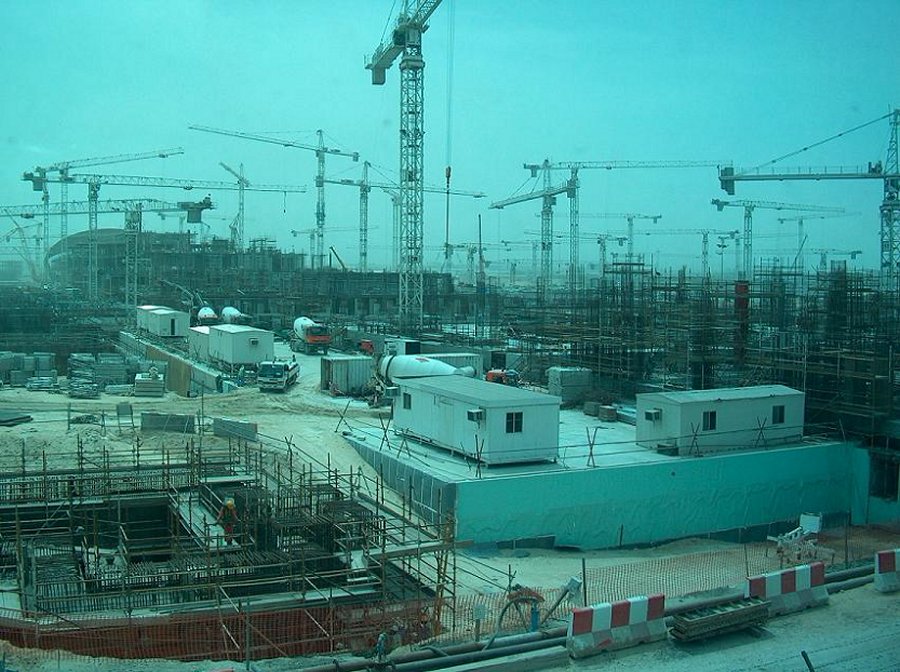
Dubai Extension Airport |
| |
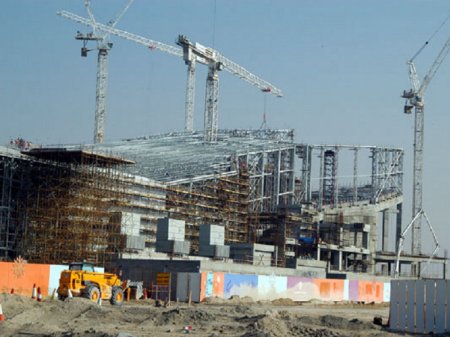
World Biggest Ski Dome
|
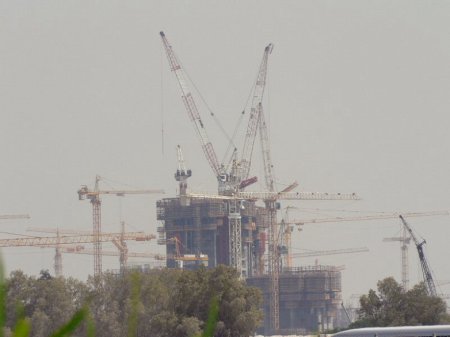
Within Mall of Emirates |
|
|
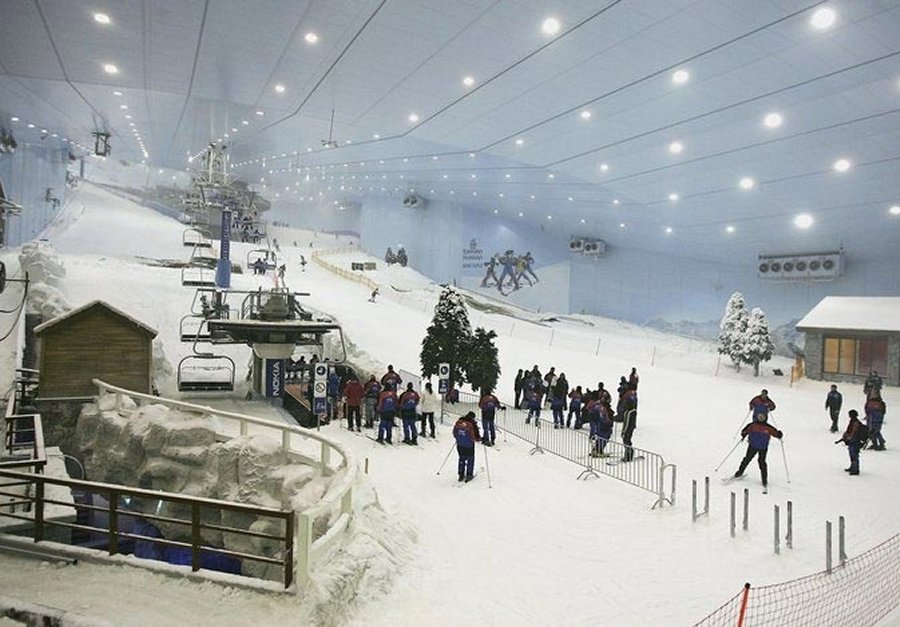
Taking a page out of the
Jamaican Bobsledding team, do you suppose Dubai intends to
field a ski team for the Winter Olympics? This
facility is so preposterous, it just boggles the mind.
Psst - take a look at the lift lines - they are the shortest
in the world! Why? That's easy - Because no one
in Dubai knows how to ski!
|
| |
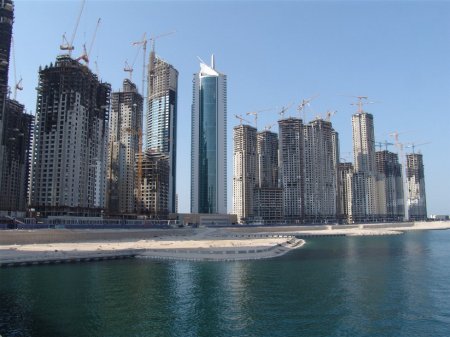
Dubai Marina Project |
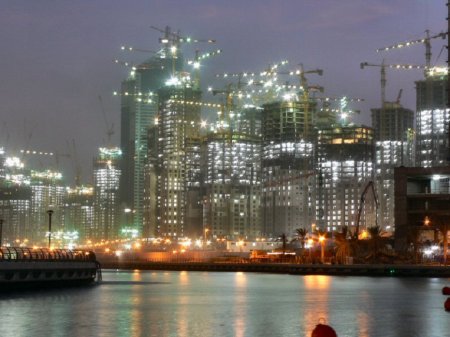
Jumeirah Beach
Residences (40 blocks) |
| |
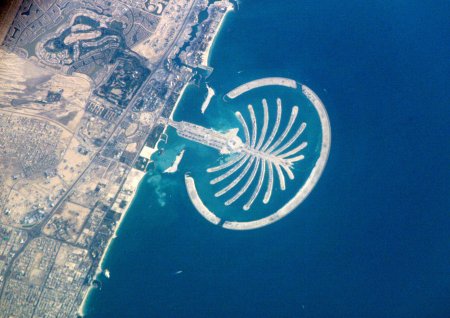 |
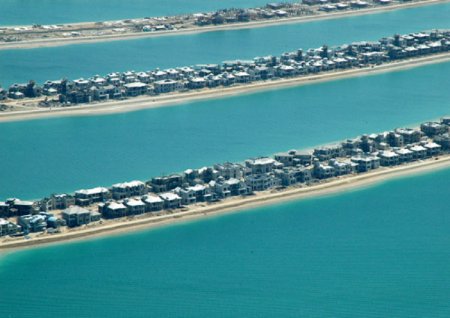 |
| |
|
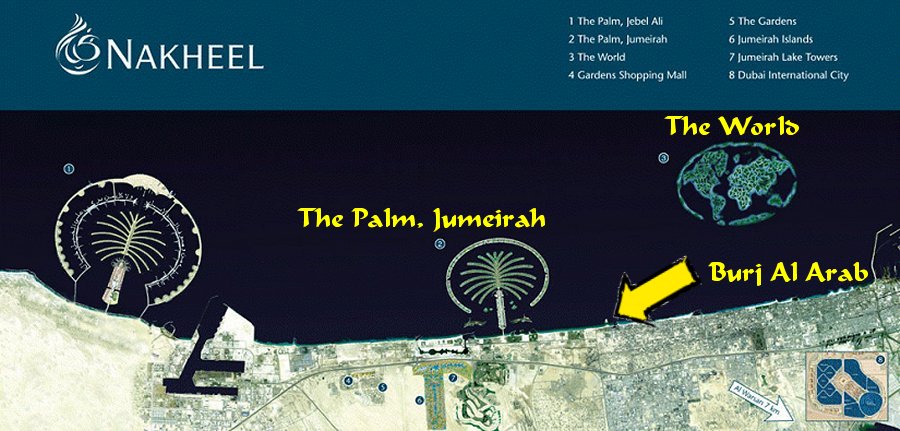
World Largest "Palms"- Jumeirah
Palm, Jebel Ali Palm, The World, Deira Palm (Hidden)
|
|

In the picture above, you get a
wonderful look at the Burj Al Arab Hotel directing below as
well as the enormous Jumeirah Palms real estate project that
stretches far out into the Persian Gulf. They must
have dumped a lot of sand into the ocean to create something
that massive.
Then in the picture directly below,
you see another view of The Jumeirah Palms and the Burj Al
Arab Hotel (on the far right) from the opposite direction.
You also get a good look at all the
skyscrapers. Take note of the Dubai Marina
project as well... they have created a massive canal that
stretches for a mile. Will gondolas be next?
|
|
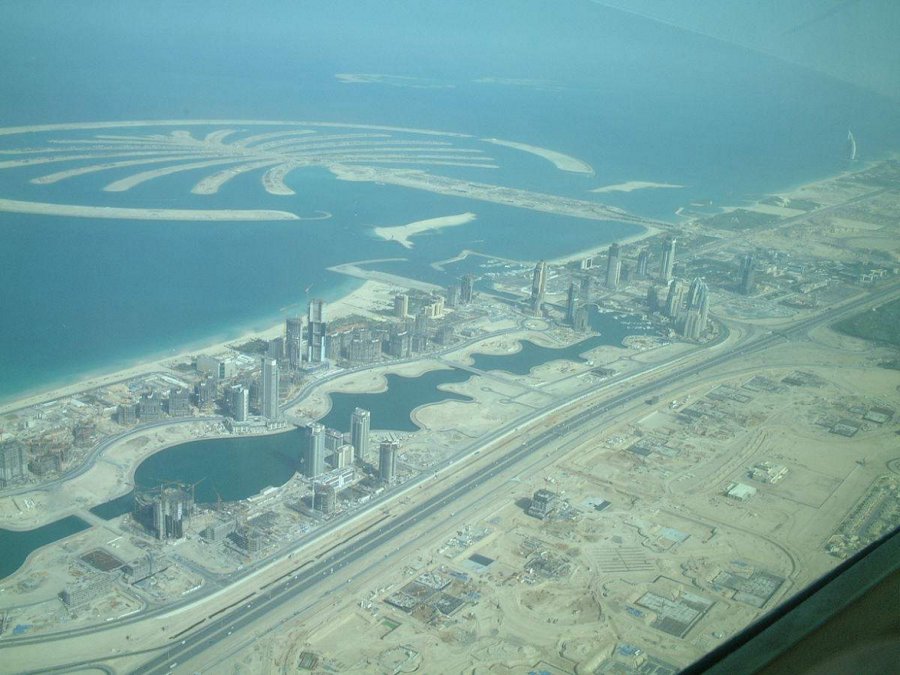
Take another look at the
above picture. It is easy to see "The
Palms - Jumeirah", but if you look closely you will see the
"The World" at the
upper center of the picture as well in its beginning stages of
development.
|
|
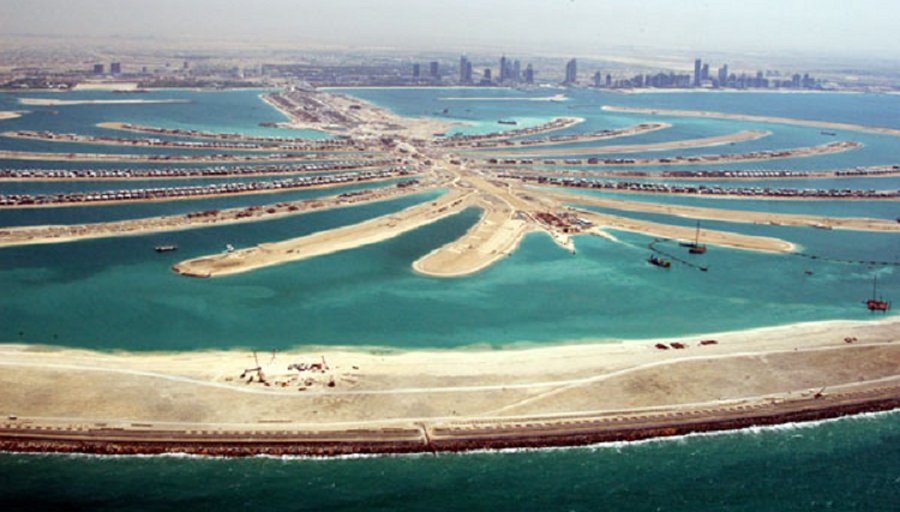
Jumeirah Palm (The smallest
Palm)
|
|
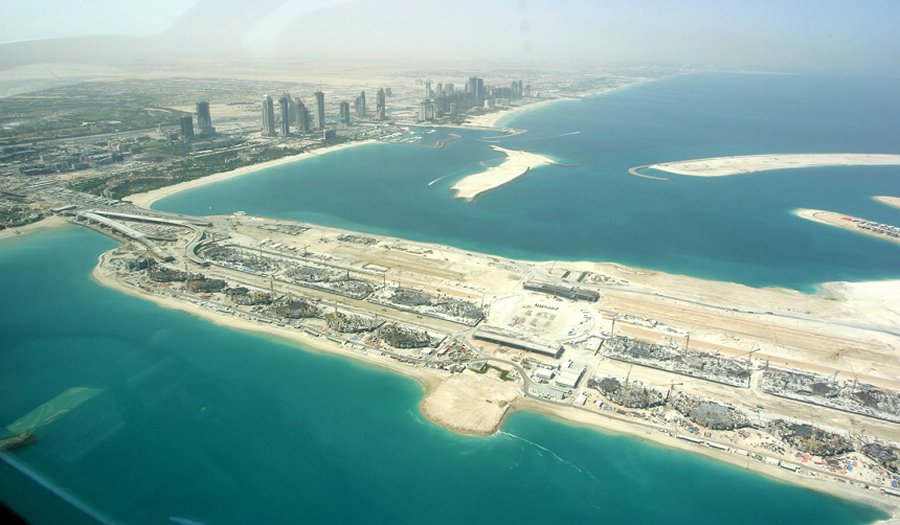 |
|
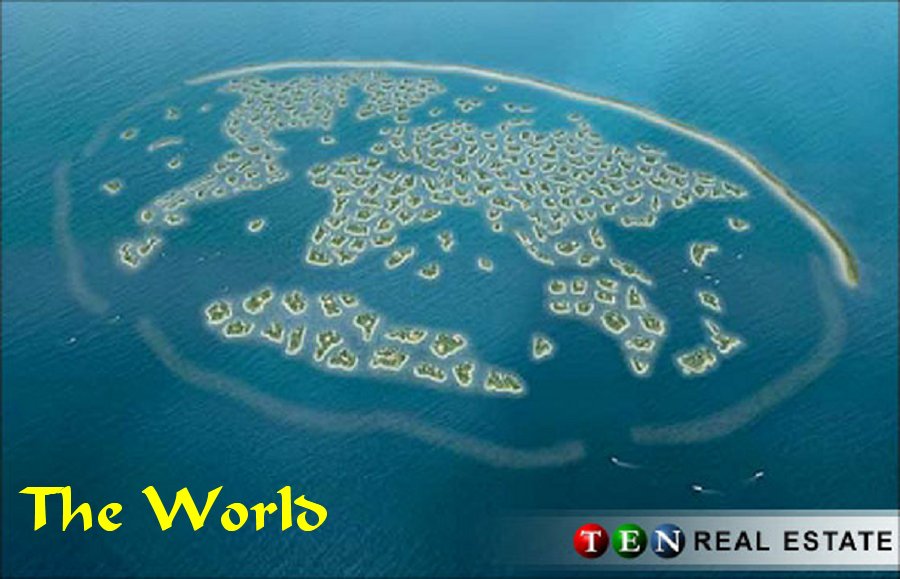 |
| |
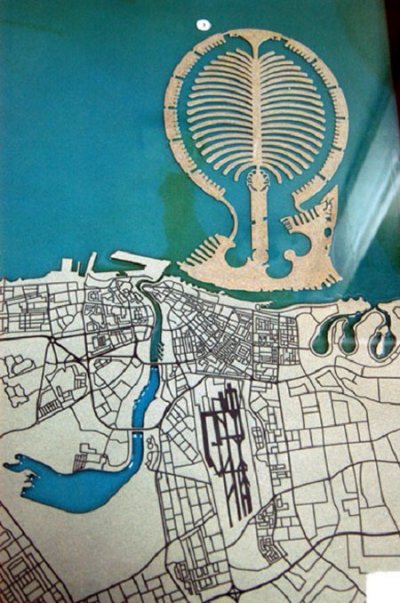
Another Palm: Deira Palm
(Largest) |
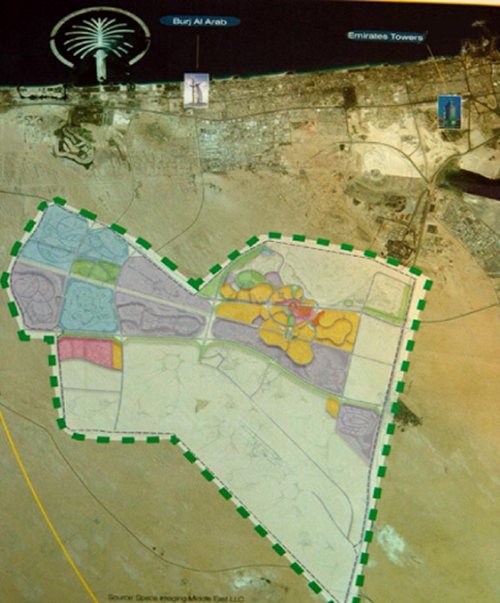
Dubailand Aerial
Photo |
| |
Disquieting Words regarding Dubai
May 8, 2007: "In a thousand years,
when the West and East are still rocking along
creating value, these Middle East monuments to
extravagant wasted wealth will have long ago
disappeared into the empty sands.
Take a hard look at
the pictures now for a good example of
bad investment. How many libraries could
that have paid for? How many books could have
been translated into Arabic?
This scenario is reminiscent of how
the Spanish blew their injection of gold and
treasure 500 years ago."
Quote from Lester B in an email to
Rick Archer
|
| |
|
Dubai plans first rotating skyscraper
(USA Today)
Posted 11/29/2006
DUBAI, United Arab Emirates (AP) — The Arab city with the
palm-shaped islands and the sail-shaped hotel is adding to
its eclectic skyline by building the world's first rotating
skyscraper, a 30-story apartment tower that revolves on its
base.
The tower, announced Wednesday, will use the Persian Gulf's
abundant sunshine to power the building's slow rotation that
brings it full circle once a week, said Nick Cooper, a
British engineer designing the rotation mechanism.
"This will be a fair building," said Cooper, of M.G. Bennett
and Associates Ltd. of Rotherham, England. "Everybody will
have the same views for the same amount of time, so you
won't have certain rooms with the best view."
The 80,000-ton building with 200 apartments will sit on a
giant bearing 30 yards in diameter, coated with a nearly
frictionless polymer, Cooper said. Twenty small electric
engines will turn the building a few degrees each hour,
Cooper said.
"It will be indexing around on the hour," Cooper said. "It
moves very slowly. It's not a theme park ride."
But a theme park's manmade lakes, malls and simulated
dinosaur park will be the primary view from the so-called
Time Residences. The developer plans to complete the
structure by 2009 as a centerpiece in the giant Dubailand
amusement park now under construction.
|
Work on the rotating tower is to begin in
June 2007.
Cooper's previous rotating projects include
the drill machine that bored the English Channel Tunnel and
a rotating rock crushing unit used in giant mining
operations.
Dubai has used a slew of announcements of iconic project to
generate publicity. Most — but not all — end up being built.
The city's three palm shaped islands are in various states
of completion. The smallest is nearly finished while
construction of the largest has been halted.
Other improbable projects have been scrapped or delayed,
including a heavily touted underwater hotel that was
canceled.
Plans call for the rotating building to incorporate a
swimming pool and a crescent-shaped "moon lounge" on the
rooftop, with a theater and observatory.
"Not only will it defy the laws of gravity and momentum, but
also it stands to redefine the standards for luxury living
in the region and the world," said Tav Singh of Dubai
Property Ring.
|
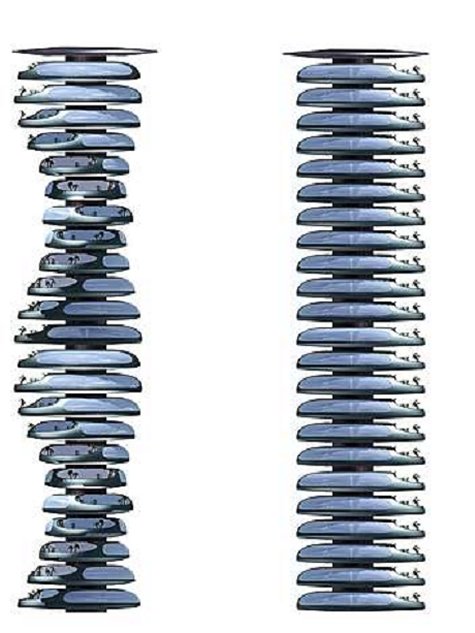 |
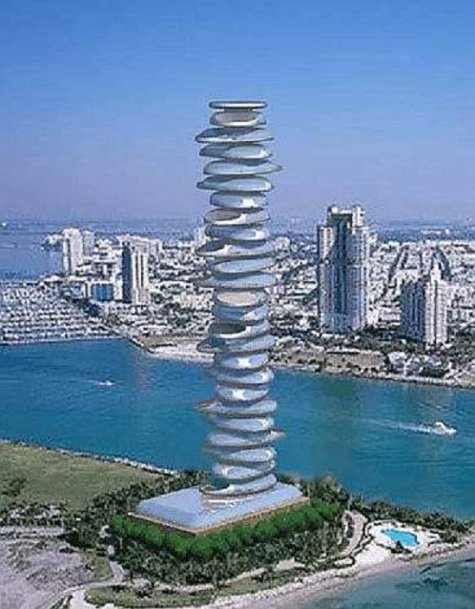 |
 |
| |
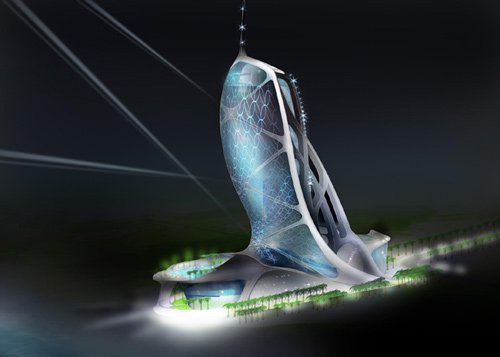
Dubai, a place that represents what happens when a few people
have way, way too much money,
is going soon be home to Hydropolis, the world's first
underwater luxury hotel.
Costing nearly $590 million to build, the 220-suite hotel should
be completed in December.
I don't know about you guys, but every movie I've seen about
people living underwater ends with aliens arriving
or a giant squid attacking or the Russians shooting off a nuke
or something. I'll stick to staying on dry land, thanks.
|
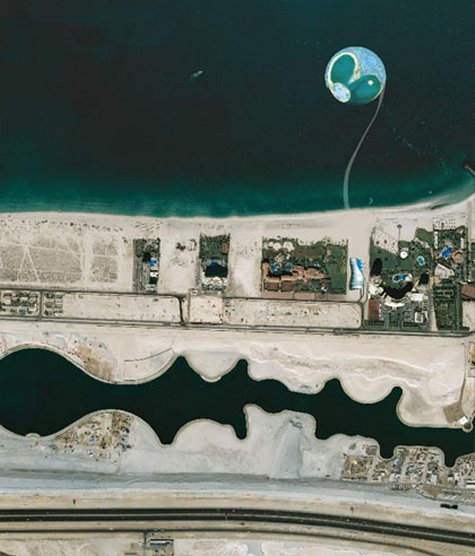
Aerial View of the Land-Sea connection to
Hydropolis. |

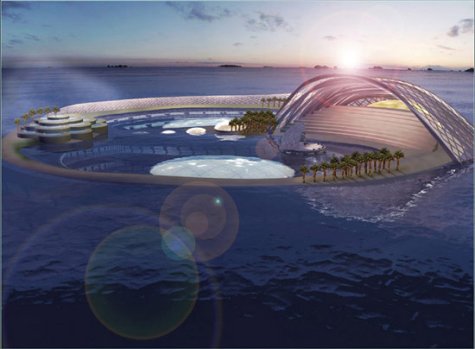 |
(Editor's Note: Bad news. When I researched the Internet for
information on the Rotating Skyscraper in March 2007, I
found a USA Today article that said,
"Other
improbable projects in Dubai have
been scrapped or delayed, including a heavily touted
underwater hotel that was canceled."
Too bad. Like the desert ski slope, this underwater
hotel was a project the world desperately needed.
|
| |
|
World Largest Themepark: Dubai Land (2009) |
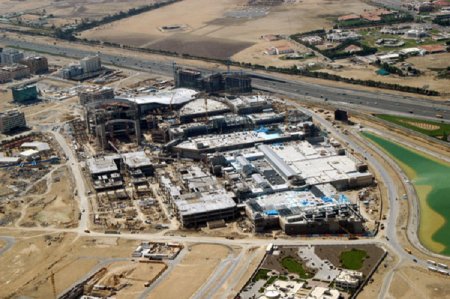 |
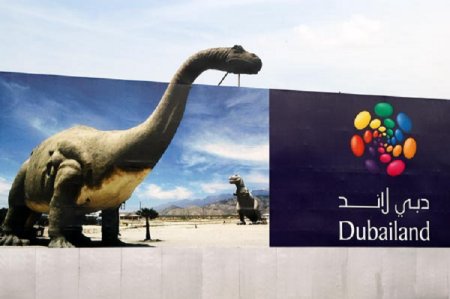 |
What on earth is going on over in the United Arab Emirates??
Forward:
As I researched for the story about the
Sultan's Palace and Dubai City, I stumbled across a
fascinating article written by Mike Davis in July 2005 for
Mother Jones. Here is the link to the
original
article.
If Mike Davis or a representative of
Mother Jones objects to my reprint of this story, I will
remove it instantly from my web site.
I am simply trying to share an amazing story with as many
people as people.)
Before you read the article, how about a
jaw-breaking look at the new "Tallest Building in the
World"?
The "Burj Dubai" is scheduled for completion in November
2008.
|
|
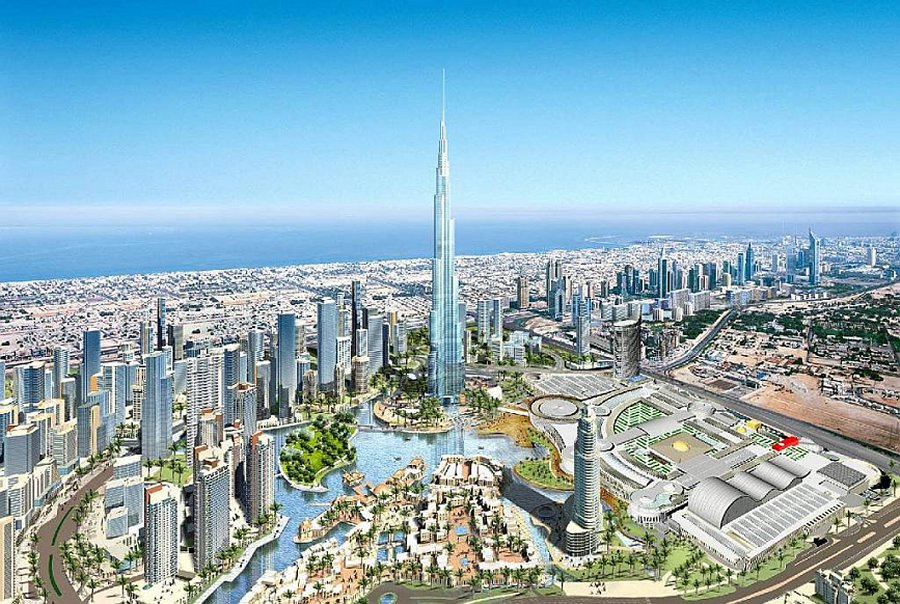
Burj Dubai Tower - World tallest (2008) |
The Narration begins:
As your jet
starts its descent, you are glued to your window. The scene
below is astonishing: a 24-square-mile archipelago of
coral-colored islands in the shape of an almost finished
puzzle of the world. In the shallow green waters between
continents, the sunken shapes of the Pyramids of Giza and
the Roman Coliseum are clearly visible.
In the
distance are three other large island groups configured as
palms within crescents and planted with high-rise resorts,
amusement parks, and a thousand mansions built on stilts
over the water. The "Palms" are connected by causeways to a
Miami-like beachfront chock-a-block full of mega-hotels,
apartment high-rises and yacht marinas.
As the plane
slowly banks toward the desert mainland, you gasp at the
even more improbable vision ahead. Out of a chrome forest of
skyscrapers (nearly a dozen taller than 1000 feet) soars a
new Tower of Babel. It is an impossible one-half-mile high:
the equivalent of the Empire State Building stacked on top
of itself.
You are still rubbing your eyes with
wonderment and disbelief when the plane lands and you are
welcomed into an airport emporium where hundreds of shops
seduce you with Gucci bags, Cartier watches, and
one-kilogram bars of solid gold. You make a mental note to
pick up some duty-free gold on your way out.
The
hotel driver is waiting for you in a Rolls Royce Silver
Seraph. Friends have recommended the Armani Hotel in the
160-story tower or the seven-star hotel with an atrium so
huge that the Statue of Liberty would fit inside, but
instead you have opted to fulfill a childhood fantasy. You
always have wanted to be Captain Nemo in Twenty Thousand
Leagues Under the Sea.
Your jellyfish-shaped hotel
is, in fact, exactly 66 feet below the sea surface. Each of
its 220 luxury suites has clear Plexiglas walls that provide
spectacular views of passing mermaids as well as the hotel's
famed "underwater fireworks:" a hallucinatory exhibition of
"water bubbles, swirled sand, and carefully deployed
lighting." Any initial anxiety about the safety of your
sea-bottom resort is dispelled by the smiling concierge. The
structure has a multi-level failsafe security system, he
reassures you, that includes protection against terrorist
submarines as well as missiles and aircraft.
Although you have an important business meeting at the
Internet City free-trade zone with clients from Hyderabad
and Taipei, you have arrived a day early to treat yourself
to one of the famed adventures at the Restless Planet
dinosaur theme park. Indeed, after a soothing night's sleep
under the sea, you are aboard a monorail headed for a
Jurassic jungle. Your expedition encounters some peacefully
grazing Apatosaurs, but you are soon attacked by a nasty
gang of velociraptors. The animatronic beasts are so
flawlessly lifelike -- in fact, they have been designed by
experts from the British Museum of Natural History -- that
you shriek in fear and delight.
With your adrenaline
pumped-up by this close call, you polish off the afternoon
with some thrilling snowboarding on the local black diamond
run. Next door is the Mall of Arabia, the world's largest
mall -- the altar of the city's famed Shopping Festival that
attracts 5 million frenetic consumers each January -- but
you postpone the temptation.
Instead, you indulge in
some expensive Thai fusion cuisine at a restaurant near
Elite Towers that was recommended by your hotel driver. The
gorgeous Russian blond at the bar keeps staring at you with
almost vampire-like hunger, and you wonder whether the local
sin scene is as extravagant as the shopping?..
The
Sequel to Blade Runner?
Welcome to paradise. But
where are you? Is this a new science-fiction novel from
Margaret Atwood, the sequel to Blade Runner, or Donald Trump
tripping on acid?
No, it is the Persian Gulf
city-state of Dubai in 2010.
After Shanghai (current
population: 15 million), Dubai (current population: 1.5
million) is the world's biggest building site: an emerging
dreamworld of conspicuous consumption and what locals dub
"supreme lifestyles."
Dozens of outlandish
mega-projects -- including "The World" (an artificial
archipelago), Burj Dubai (the Earth's tallest building), the
Hydropolis (that underwater luxury hotel, the Restless
Planet theme park, a domed ski resort perpetually maintained
in 40C heat, and The Mall of Arabia, a hyper-mall -- are
actually under construction or will soon leave the drawing
boards.
A satellite photo of 'Jebel Ali Palm
Island,' the second Palm Island to be built off the coast of
Dubai. Eventually, three palm-shaped artificial islands will
be built in the Dubai area. The first one, 'Jumeira Palm' is
almost completed.
Under the enlightened despotism of its Crown Prince and CEO,
56-year-old Sheikh Mohammed bin Rashid al-Maktoum, the
Rhode-Island-sized Emirate of Dubai has become the
new global icon of 'imagine'-engineered urbanism.
|
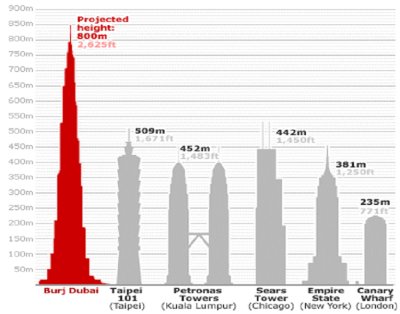 |
Although often
compared to Las Vegas, Orlando, Hong Kong or Singapore, the
sheikhdom is more like their collective summation: a
pastiche of the big, the bad, and the ugly. It is not just a
hybrid but a chimera: the offspring of the lascivious
coupling of the cyclopean fantasies of Barnum, Eiffel,
Disney, Spielberg, Jerde, Wynn, and Skidmore, Owings &
Merrill.
Multibillionaire Sheik Mohammed -- as he's
affectionately known to Dubai's expats -- not only collects
thoroughbreds (the world's largest stable) and super-yachts
(the 525-foot-long Project Platinum which has its own
submarine and flight deck), but also seems to have imprinted
Robert Venturi's cult Learning from Las Vegas in the same
way that more pious Moslems have memorized The Quran. (One
of the Sheik's proudest achievements, by the way, is to have
introduced gated communities to Arabia.)
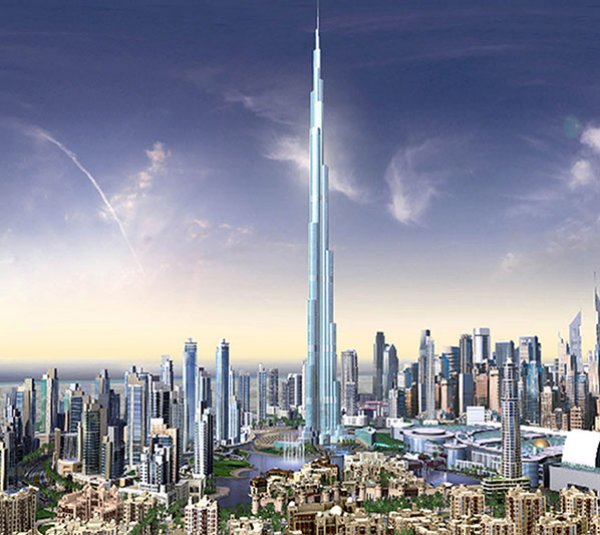 |
Under his leadership, the coastal
desert has become a huge circuit board into which
the elite of transnational engineering firms and
retail developers are invited to plug in high-tech
clusters, entertainment zones, artificial islands,
"cities within cities" -- whatever is the latest fad
in urban capitalism.
The same phantasmagoric but generic Lego blocks, of
course, can be found in dozens of aspiring cities
these days, but Sheik Mohammed has a distinctive and
inviolable criterion: Everything must be "world
class," by which he means number one in The Guinness
Book of Records. Thus Dubai is building the world's
largest theme park, the biggest mall, the highest
building, and the first sunken hotel among other
firsts.
Sheikh Mohammed's architectural
megalomania, although reminiscent of Albert Speer
and his patron, is not irrational.
Having "learned from Las Vegas," he understands that
if Dubai wants to become the luxury-consumer
paradise of the Middle East and South Asia (its
officially defined "home market" of 1.6 billion), it
must ceaselessly strive for excess.
|
From
this standpoint, the city's monstrous caricature of futurism
is simply shrewd marketing. Its owners love it when
designers and urbanists anoint it as the cutting edge.
Architect George Katodrytis wrote: "Dubai may be considered
the emerging prototype for the 21st century: prosthetic and
nomadic oases presented as isolated cities that extend out
over the land and sea."
Moreover, Dubai can count on
the peak-oil epoch to cover the costs of these hyperboles.
Each time you spent $40 to fill your tank, you are helping
to irrigate Sheik Mohammed's oasis.
Precisely because
Dubai is rapidly pumping the last of its own modest
endowment of oil, it has opted to become the postmodern
"city of nets" -- as Bertolt Brecht called his fictional
boomtown of Mahoganny -- where the super-profits of oil are
to be reinvested in Arabia's one truly inexhaustible natural
resource: sand. (Indeed mega-projects in Dubai are usually
measured by volumes of sand moved: 1 billion cubic feet in
the case of The World.)
Al-Qaeda and the war on
terrorism deserve some of the credit for this boom. Since
9/11, many Middle Eastern investors, fearing possible
lawsuits or sanctions, have pulled up stakes in the West.
According Salman bin Dasmal of Dubai Holdings, the Saudis
alone have repatriated one-third of their trillion-dollar
overseas portfolio. The sheikhs are bringing it back home,
and last year, the Saudis were believed to have ploughed at
least $7 billion into Dubai's sand castles.
Another
aqueduct of oil wealth flows from the neighboring Emirate of
Abu Dhabi. The two statelets dominate the United Arab
Emirates -- a quasi-nation thrown together by Sheik Mohammed's
father and the ruler of Abu Dhabi in 1971 to fend off
threats from Marxists in Oman and, later, Islamists in Iran.
Today, Dubai's security is guaranteed by the
American nuclear super-carriers usually berthed at the port
of Jebel Ali. Indeed, the city-state aggressively promotes
itself as the ultimate elite "Green Zone" in an increasingly
turbulent and dangerous region.
Meanwhile, as
increasing numbers of experts warn that the age of cheap oil
is passing, the al-Maktoum clan can count on a torrent of
nervous oil revenue seeking a friendly and stable haven.
When outsiders question the sustainability of the current
boom, Dubai officials point out that their new Mecca is
being built on equity, not debt.
Since a watershed
2003 decision to open unrestricted freehold ownership to
foreigners, wealthy Europeans and Asians have rushed to
become part of the Dubai bubble.
A beachfront in one of the "Palms" or, better yet, a private
island in "The World" now has the cachet of St. Tropez or
Grand Cayman. The old colonial masters lead the pack as Brit
expats and investors have become the biggest cheerleaders
for Sheikh Mohammed's dreamworld: David Beckham owns a beach and
Rod Stewart, an island (rumored, in fact, to be named Great
Britain).
The utopian character of Dubai, it must be
emphasized, is no mirage. Even more than Singapore or Texas,
the city-state really is an apotheosis of neo-liberal
values.
On the one hand, it provides investors with
a comfortable, Western-style, property-rights regime,
including freehold ownership, that is unique in the region.
Included with the package is a broad tolerance of booze,
recreational drugs, halter tops, and other foreign vices
formally proscribed by Islamic law. (When expats extol
Dubai's unique "openness," it is this freedom to carouse --
not to organize unions or publish critical opinions -- that
they are usually praising.)
On the other hand,
Dubai, together with its emirate neighbors, has achieved the
state of the art in the disenfranchisement of labor. Trade
unions, strikes, and agitators are illegal, and 99% of the
private-sector workforce are easily deportable non-citizens.
Indeed, the deep thinkers at the American Enterprise and
Cato institutes must salivate when they contemplate the
system of classes and entitlements in Dubai.
At the
top of the social pyramid, of course, are the al-Maktoums
and their cousins who own every lucrative grain of sand in
the sheikhdom. Next, the native 15% percent of the
population -- whose uniform of privilege is the traditional
white dishdash -- constitutes a leisure class whose
obedience to the dynasty is subsidized by income transfers,
free education, and government jobs. A step below, are the
pampered mercenaries: 150,000-or-so British ex-pats, along
with other European, Lebanese, and Indian managers and
professionals, who take full advantage of their
air-conditioned affluence and two-months of overseas leave
every summer.
However, South Asian contract
laborers, legally bound to a single employer and subject to
totalitarian social controls, make up the great mass of the
population. Dubai lifestyles are attended by vast numbers of
Filipina, Sri Lankan, and Indian maids, while the building
boom is carried on the shoulders of an army of poorly paid
Pakistanis and Indians working twelve-hour shifts, six and
half days a week, in the blast-furnace desert heat.
Dubai, like its neighbors, flouts ILO labor regulations and
refuses to adopt the international Migrant Workers
Convention. Human Rights Watch in 2003 accused the Emirates
of building prosperity on "forced labor." Indeed, as the
British Independent recently emphasized in an exposé on
Dubai, "The labour market closely resembles the old
indentured labour system brought to Dubai by its former
colonial master, the British."
"Like their
impoverished forefathers," the paper continued, "today's
Asian workers are forced to sign themselves into virtual
slavery for years when they arrive in the United Arab
Emirates. Their rights disappear at the airport where
recruitment agents confiscate their passports and visas to
control them"
In addition to being super-exploited,
Dubai's helots are also expected to be generally invisible.
The bleak work camps on the city's outskirts, where laborers
are crowded six, eight, even twelve to a room, are not part
of the official tourist image of a city of luxury without
slums or poverty. In a recent visit, even the United Arab
Emirate's Minister of Labor was reported to be profoundly
shocked by the squalid, almost unbearable conditions in a
remote work camp maintained by a large construction
contractor. Yet when the laborers attempted to form a union
to win back pay and improve living conditions, they were
promptly arrested.
Paradise, however, has even
darker corners than the indentured-labor camps. The Russian
girls at the elegant hotel bar are but the glamorous facade
of a sinister sex trade built on kidnapping, slavery, and
sadistic violence. Dubai -- any of the hipper guidebooks
will advise -- is the "Bangkok of the Middle East,"
populated with thousands of Russian, Armenian, Indian, and
Iranian prostitutes controlled by various transnational
gangs and mafias. (The city, conveniently, is also a world
center for money laundering, with an estimated 10% of real
estate changing hands in cash-only transactions.)
Sheikh Mohammed and his thoroughly modern regime, of course,
disavow any connection to this burgeoning red-light
industry, although insiders know that the whores are
essential to keeping all those five-star hotels full of
European and Arab businessmen. But the Sheikh himself has
been personally linked to Dubai's most scandalous vice:
child slavery.
Camel racing is a local passion in
the Emirates, and in June 2004, Anti-Slavery International
released photos of pre-school-age child jockeys in Dubai.
HBO Real Sports simultaneously reported that the jockeys,
"some as young as three -- are kidnapped or sold into
slavery, starved, beaten and raped." Some of the tiny
jockeys were shown at a Dubai camel track owned by the al-Maktoums.
The Lexington Herald-Leader -- a newspaper in
Kentucky, where Sheikh Mohammed has two large thoroughbred farms
-- confirmed parts of the HBO story in an interview with a
local blacksmith who had worked for the crown prince in
Dubai. He reported seeing "little bitty kids" as young as
four astride racing camels. Camel trainers claim that the
children's shrieks of terror spur the animals to a faster
effort.
Sheikh Mohammed, who fancies himself a prophet of
modernization, likes to impress visitors with clever
proverbs and heavy aphorisms. A favorite: "Anyone who does
not attempt to change the future will stay a captive of the
past."
Yet the future that he is building in Dubai
-- to the applause of billionaires and transnational
corporations everywhere -- looks like nothing so much as a
nightmare of the past: Walt Disney meets Albert Speer on the
shores of Araby.
..............
Mike Davis is the author of "Dead
Cities" and the forthcoming Monster at the Door: the Global
Threat of Avian Influenza (New Press 2005).
Copyright 2005 Mike Davis
This piece first appeared
at Tomdispatch.com.
Email
Received Regarding the Above Story
-----Original Message-----
From: Shams Islam
Sent: Wednesday, October 10, 2007 3:10 PM
To: dance@ssqq.com
Subject: Sheikh Mo?
You
have used 'Mo' for Mohammed referring to Sheikh Mohammed.
It is very offensive to call
some one Mo.
Can you please make the necessary
change?
Thanks,
Shams
-----Original Message-----
From: Rick Archer
Sent: Monday, October 22, 2007 10:43 AM
To: Shams Islam
Subject: RE: Sheikh Mo?
I never used the term 'Mo' myself.
It was part of the article I reprinted. However,
after
thinking about your request for a couple weeks, I have
decided to follow your advice. Please check my work and
comment if you see any further signs of disrespect.
As far I am concerned, Sheik Mohammed is
an amazing visionary. His achievements in Dubai are so
incredible that I consider him to be one of the most
talented men on our planet today. He has created a
masterpiece that seems more science fiction than reality,
yet the pictures prove he has brought the future to the
present.
It is certainly not my intention
to be disrespectful to a man I admire.
-----Original Message-----
From: Shams Islam
Sent: Monday, October 22, 2007 1:33 PM
To: Rick Archer
Subject: RE: Sheikh Mo?
Hi Rick,
We are a global nation and thus should be aware of other
cultures and religions.
Your actions makes you a global player.
Love your site.
I now live in Dallas, Texas.
I moved to US from Abu Dhabi in 80s and the change
over there is unimaginable.
Rick Archer's Note:
I made the
requested changes in the article above on October 22, 2007.
Although in my culture this nickname does not seem to offensive, I made the change for one
reason - I consider Sheik Mohammed to be a brilliant man.
He is also a visionary of immense talent. I cannot
imagine where the human race would be without men of this
ability. Since I myself feel humbled by the Sheik's
accomplishments, I made the change voluntarily to show my
respect for this man. Wherever Sheik Mohammed's name
is highlighted, this is one of the ten changes I made.
It is my hope that Sheik Mohammed continues to enjoy health and
safety for he does the world a great service. I also
wish him continued success as he attempts to build a
peaceful bridge between the cultures of the West and the
Arab world.
|
|
|